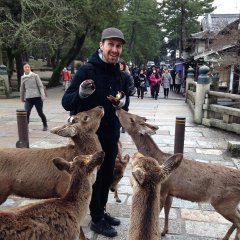As travel or spiritual destinations, temples and shrines are often on the itineraries of first time travelers to Japan. For some visitors, their interest is satisfied after seeing the first few famous sites. However, for others like me, the appeal remains visit after visit. If you are like me, you may want to go deeper by following pilgrimage circuits.
What is a pilgrimage?
The definition of pilgrimage is self-explanatory; a journey made to a sacred place as an act of religious devotion. In the past, when walking was the most used way to travel, a trip to one sacred location, like Mount Fuji, Mount Koya or Ise Shrine was a serious undertaking as it was a long journey. Other pilgrimages would involve visiting several locations, such as the Shikoku pilgrimage, that will bring the pilgrims to 88 temples stretched on a 1200 km route around Shikoku island.
Nowadays, pilgrimages can be done on foot, by bicycle, car, tour bus, and train. Reasons to make journeys can range from devotion, prayers for good luck, time for personal reflection, or simply for sightseeing. Courses can involve several locations, from just a handful to dozens on a circuit stretching over multiple prefectures.
Etiquette
Whether you follow Buddhism or Shinto or not, temples and shrines welcome visitors who show genuine interest. For routine days, basic etiquette applies, but during festivals, sutra reading p and lightings for candles might be included in rituals. Many locations are dedicated to a specific bodhisattva or god, so you may want to learn about representations of that figure.
The important thing to remember is that temples and shrines are sacred places, not amusements. During your visit, even if you do not follow all the rituals, please mind proper manners and do not disturb people at devotions and prayers.
Finding a pilgrimage
Aside from the most famous pilgrimages, information in languages other than Japanese might be challenging to gather. Search in your browser with the right keywords and you may be able to discover locations and circuits of interest to you.
The first keyword to use is reijō (霊場), simply meaning "sacred place". It might sound too general, but many temple circuits have titles that end with this word. so a search may produce many results. Note that pilgrimage, commonly referred to as junrei (巡礼) will also turn up search results in Chinese. You might have more luck with with the term meguri (巡り), meaning tour and pilgrimage. Narrow your search by combining it with words such as temple(寺) or shrine (神社). Alternative words for pilgrimage are junpai (巡拝), which may yield some good results and henro (遍路) which is associated with the Shikoku 88 temples route. One more useful search term is shinbutsu (神仏), indicating both Shinto and Buddhism.
If you combine these terms in a search, you might find the Shinbutsu reijō junpai no michi (神仏霊場巡拝の道) , a circuit of 151 temples and shrines in the Kinki (kansai) region.
Also look up temples on Wikipedia, as pilgrimages are often listed in the info box as fudasho-tō (札所等). Follow links to discover more circuits.
Selecting a pilgrimage
When choosing a pilgrimage consider the number of sites, the locations, the access to transportation, timing, the memorabilia available, and the figue worshiped.
When searching for the name of the pilgrimage, you will discover official websites that list temples and shrines. To ease your search, include the word map chizu (地図). Image search and Wikipedia can reveal more, and even pages in English. Search the English name to find reports by previous travelers. Note that some pilgrimage circuits may be dormant.
Some sites will be very far apart, limiting you to one or two a day. You may want to budget time for excursions to other attractions along the way, too. Temple and shrine offices keep business hours, so mind the time.
For a first course, I suggest a short pilgrimage route. If you are in Japan for the two first weeks of January, try the seven gods of luck courses (七福神巡り). These are usually easy to complete on foot in a single day, and the sites offer charms and memorabilia at the beginning of the year. Other short courses have fewer than 20 sites.
If you are ready for deeper experiences and long hikes, some options are the Kumano kodō pilgrimage routes or the Shikoku pilgrimage, as they both have well frequented trails. These may take days or weeks to complete, so they require more organization, gear, and reservations.
Memorabilia
If you want to commemorate your pilgrimage, you will find many items on offer. The most common is goshuin, a stamp and calligraphy that can be done on different medium, including scrolls, posters, and books specially designed for the pilgrimage. In some cases, there is no pilgrimage specific medium, so you can receive the goshuin in a generic book, but make sure to ask the goshuin that is specific to the pilgrimage you are on, as some shrines and temples have several designs, one for each pilgrimage they are part of.
Other options are rosary beads, ema (votive tablets), sange (lotus flower shaped paper charm), osugata (sacred image), small figurines (especially for the seven gods of luck) and other charms.
Conclusion
What first sparked my interest in completing a pilgrimage was my love for the architecture of temples and shrines as well as the unique atmosphere that can be found in these places; the smell of the incense, the sound on the coins tossed in the offering box, the beautiful gardens. What I discovered while doing my first pilgrimage, is that you might end up visiting some well known places, bustling with activities and other times end up being the only visitor. If you embark on such a journey, I hope that like me, you will find something, that might provide time for thought and meditation, a feeling of accomplishment, or simply good memories.
Resource and links
- Online in Japanese
- Online in English







